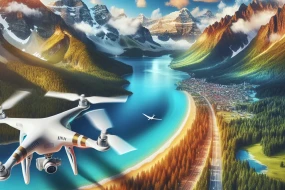
In an era where capturing and sharing your travel experiences has become almost as important as the journey itself, knowing how to document your travels digitally is a skill worth mastering. Whether you’re a seasoned globetrotter or a casual vacationer, creating a vivid and engaging digital record of your adventures can enrich your travel experiences and help you connect with a wider audience. From choosing the right tools to understanding the nuances of storytelling, this guide will walk you through the essential steps to document your travels like a pro.
Choosing the Right Tools for Digital Documentation
Before you embark on your journey, it's crucial to arm yourself with the right digital tools. Smartphones, with their high-quality cameras and array of apps, are often the go-to devices for many travelers. However, a dedicated camera can offer superior image quality and more control over your photography. Consider using a lightweight mirrorless camera if you're serious about photography. Beyond hardware, apps like Google Photos or Adobe Lightroom can help you organize and edit your images, ensuring they’re ready for sharing.
Don't overlook the importance of a reliable internet connection. Portable Wi-Fi devices or local SIM cards can keep you connected, allowing you to share your experiences in real-time. Remember, the goal is to capture moments without being bogged down by technology. Choose tools that enhance your experience, not complicate it.
Crafting a Compelling Narrative
Every great travel story has a beginning, a middle, and an end. As you document your travels, think about the story you want to tell. Is it about cultural exploration, adventure, or personal growth? Crafting a narrative will guide your documentation process, helping you decide what to capture and how to present it.
Start by setting the scene. Capture the essence of your destination with wide shots that show the landscape or cityscape. As you dive deeper into your journey, focus on the details that make your experience unique—whether it’s the intricate patterns of local textiles or the vibrant colors of a bustling market. Conclude your story by reflecting on your journey. What did you learn? How did the experience change you? These personal insights can add depth to your narrative, making it more relatable and engaging.
Photography Tips for Travelers
Photography is at the heart of digital travel documentation. To capture stunning images, you don't need to be a professional photographer, but a few tips can help you improve your shots. First, consider the rule of thirds to create balanced and engaging compositions. Experiment with different perspectives and angles to add interest to your photos.
Lighting is another critical factor. The golden hours—shortly after sunrise and before sunset—offer soft, warm light that can enhance your photos. If you're taking pictures indoors or in low-light conditions, steady your camera to avoid blurry images. A small tripod can be a handy tool in these situations.
Finally, don't forget to capture candid moments. These unposed shots often convey the true spirit of your travels and can be more meaningful than perfectly staged photos.
Video Documentation: Bringing Your Travels to Life
While photos capture a single moment, videos allow you to tell a more dynamic story. With the rise of platforms like YouTube and Instagram Reels, video content has become increasingly popular. Start by planning your shots—think of them as scenes in a movie. Short clips of 10-15 seconds can be more engaging and easier to edit.
Consider using a gimbal to stabilize your footage, especially if you’re filming while moving. This can make a significant difference in the quality of your videos. When editing, focus on pacing. Keep your videos concise and engaging, using transitions and music to enhance the storytelling. Remember, the sound is just as important as the visuals. Capture ambient sounds or narrate your video to provide context and depth.
Writing Engaging Travel Blogs
A travel blog is an excellent way to share your experiences in detail. Start with a captivating headline that piques interest and hints at the story within. Use an engaging introduction to draw readers in, setting the tone for the rest of the post.
When writing, be authentic and personal. Share your thoughts, emotions, and insights to create a connection with your readers. Use descriptive language to paint vivid images, but avoid overwhelming your audience with too much detail. Break up text with headings, bullet points, and images to make your blog more readable.
Finally, encourage interaction by asking questions or inviting readers to share their own experiences. This can foster a sense of community and keep readers coming back for more.
Common Mistakes to Avoid in Digital Travel Documentation
1) Overpacking Equipment: It’s easy to get carried away with gear, but remember that less is often more. Carrying too much can be cumbersome and distract from the experience.
2) Neglecting Backup: Always have a backup plan for your data. Use cloud storage solutions like Google Drive or Dropbox to ensure your memories are safe even if your device fails.
3) Ignoring Security: Be mindful of your digital security. Use VPNs when accessing public Wi-Fi to protect your data.
4) Overediting Photos: While editing can enhance your images, overdoing it can make them look unnatural. Aim for a balance that enhances the image without losing authenticity.
5) Forgetting to Live in the Moment: While documenting is important, it’s crucial to experience your travels without a lens sometimes. Put the camera down and soak in your surroundings.
6) Not Engaging with Locals: Interacting with locals can provide deeper insights and more authentic experiences, which can enrich your documentation.
7) Failing to Plan Content: Having a rough plan or outline can guide your documentation and ensure you capture key moments without missing out on the experience.
8) Ignoring Legal Restrictions: Be aware of local laws regarding photography and videography, especially in sensitive areas.
9) Focusing Only on Landmarks: While iconic sites are must-sees, capturing lesser-known spots can add depth to your travel story.
10) Not Reviewing Content: Regularly review your photos and videos to ensure quality and coherence in your narrative.






























